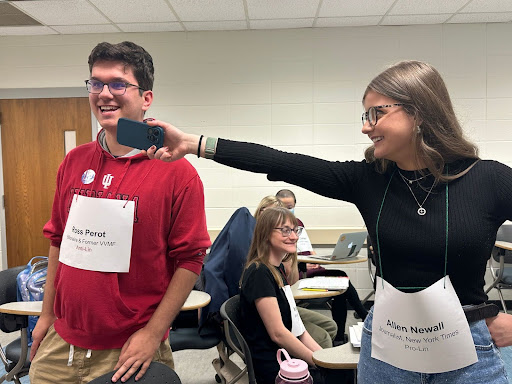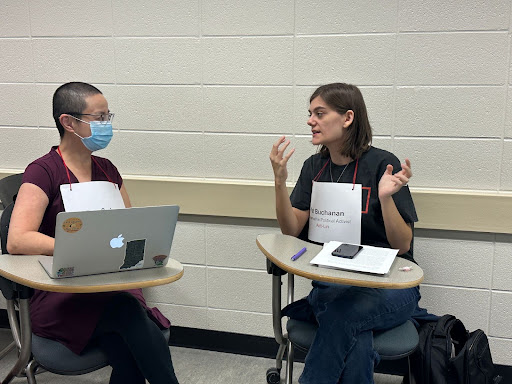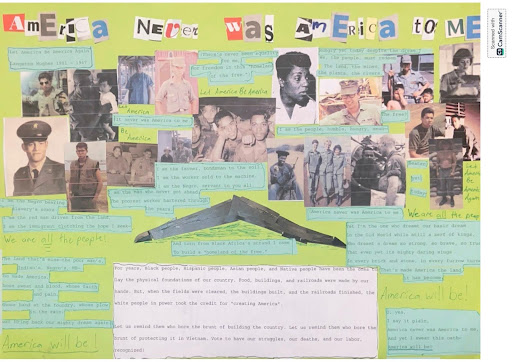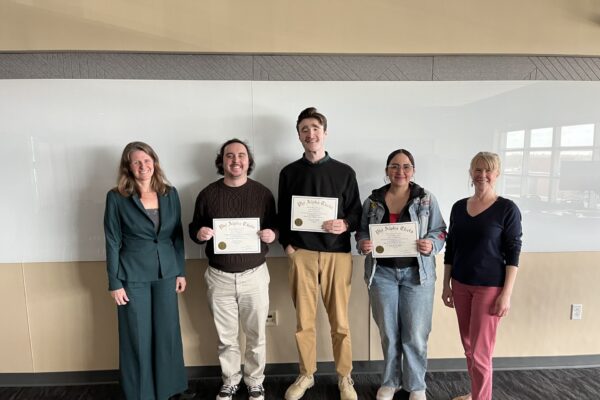
By Summer Whelan
Have you ever wondered what it would be like to go back in time? This semester, graduate students in IU Indianapolis’ Foundations of Public History course played Monuments and Memory-Making: The Debate over the Vietnam Veterans Memorial, 1981-1982, a Reacting to the Past (RTTP) game. RTTP uses historical role play to transport participants back to an important decision-making moment and take on the personas of people from that time. Characters are either historical figures or “composite characters” who represent historically-accurate viewpoints.

Kayla Price, playing the composite character of New York Times reporter Allen Newall interviews Andrew Metrick in his role as politician Ross Perot.
Players are split up into two factions. The factions in this game were either in favor of Maya Lin’s proposed Vietnam Veterans Memorial or against it. There are also a few characters who start the game as indeterminates, and each faction tries to win them over. Those in factions, despite being part of a group that shares a common goal, also have their own motives. I, for example, played the role of composite character Kristy Anderson, a nurse who had served in the Vietnam War. I was a member of the pro-Lin faction but I was the only player in the game who began with the goal of ensuring that nurses received recognition at the Vietnam Veterans Memorial.
Lin’s proposed Vietnam Veterans Memorial was controversial at the time because it did not send a clear message to visitors about the meaning and significance of the Vietnam War and focused only on those who had lost their lives in the conflict. Lin designed the monument, made of black granite, to look like a rift in the earth. In her design, the overwhelming number of names are intentionally organized to represent a timeline of casualties, broken by the memorial’s open side. The names are unified on the wall into a representation of the war’s cost in its entirety. According to the Vietnam Veterans Memorial Fund, the black granite was chosen to represent respect and dignity.¹ Lin wrote of her design:
I imagined something that would gently draw you into the park. Not destroy the park, but become one with it. It simply came about as imagining a knife cutting into the earth and opening a rift in the earth. What is a memorial? What is a war? It’s a scar… the initial violence healed over with time.²

Vietnam Veterans Memorial NPS / Victoria Stauffenberg 2000-01-01.
Students in H542 went back in time to 1981 Washington, D.C. to determine whether Lin’s proposed monument would be constructed according to her plan or if changes would be made to it. The faction proposing changes to Lin’s design wanted a memorial that portrayed U.S. participation in the Vietnam conflict in a positive light. After three weeks of lively game play, the students in the class decided to propose adding some patriotic elements to Lin’s original design.
RTTP connects to public history learning in a variety of ways. Students used sources to get into character, putting themselves in another person’s shoes and another time period. Taking on the role of a character at a different point in time, who may or may not have views that align with yours, is an important experience for those who will be interpreting the past to public audiences in their careers. While players prepared their statements before class, they also frequently had to react on the spot, especially when the game play took an unexpected turn. This was most evident in this particular game when the anti-Lin faction made a surprise move and accused one of their opponents of holding Communist beliefs, a controversial incendiary accusation in the context of the Cold War. The success of this accusation contributed directly to the outcome of the game.

A spirited discussion between Piper Booker, playing conservative commentator and politician Pat Buchanan and Cynthia Wu, playing Vietnam veteran Tom Carhart, both historical figures.
Students also had the opportunity to learn about the meaning of monuments and memorials and how difficult it often is to determine the final form a project like this will take. One student in the class, Monica Berg, wrote this about how RTTP gave her the opportunity to think about memorials and monuments: “The question of memorializing an event, especially on a national scale, always seemed like a challenging task to me. Especially with a war as long-lasting and polarizing as the Vietnam War, how can you ensure that everyone is happy with the final product? From this experience, I learned that you definitely cannot make every single supporter of a memorial satisfied. Everyone has different ideas about, and a stake in, what a memorial represents. It could be a place to spread a message or to simply mourn. A memorial always has its limitations on how much information it can present to audiences.” The RTTP game provided opportunities for community building and engaged learning. Students in the class overwhelmingly deemed it a successful project.

“America Was Never America To Me,” Newspaper ad student Sarah Wulf created in her role as Vietnam Veteran Jerry Jenkins, a composite character of a Black soldier who fought in the war.
¹Vietnam Veterans Memorial Fund, Inc., “Facts about the Vietnam Veterans Memorial,” Vietnam Veterans Memorial Fund Records, 1965-94, Library of Congress.
²“Vietnam War Memorial: Violence Healed Over by Time,” Christian Science Monitor, August 6, 1981


